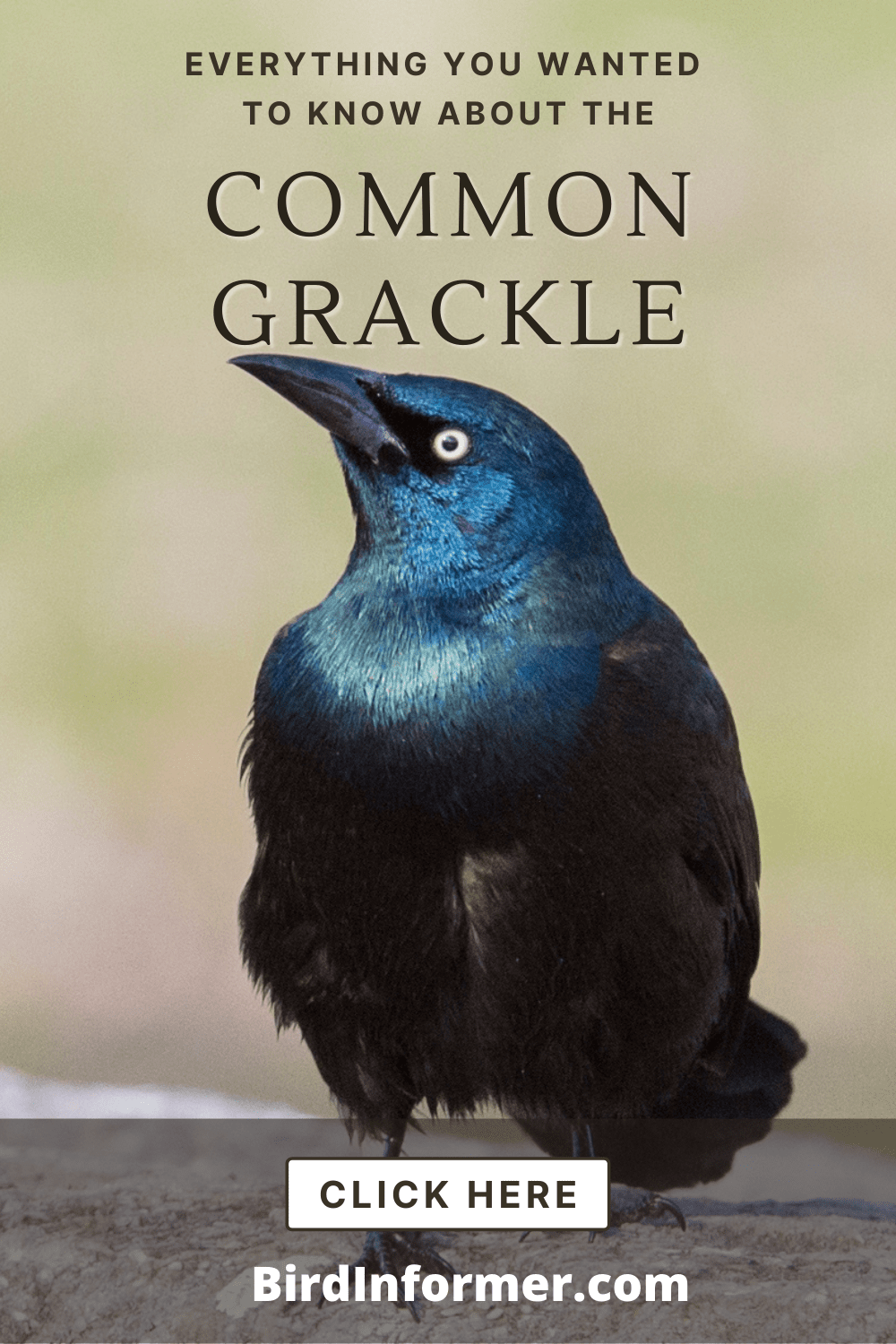Contents
- Common grackle facts
- Common grackle: how-to identify
- Common grackle bird vocalization
- Where You’ll See A Common Grackle
- Common grackle diet
- Common grackle nesting
- Common grackle behavior
- How-to attract common grackles
- Common grackle threats
- Common grackle fun & interesting facts
- Common grackle related species in this family
The Common Grackle is a large blackbird that tends to be taller and longer than most of its kind. Their tail is nearly half their length, and they have a unique color pattern. These birds would appear black from afar, but getting near them, you will notice a brassy bronze color with a bit of green, blue, or purple iridescence.
They are unique-looking birds and are not usually welcomed by homeowners as they tend to dominate the bird feeders. They are also considered agricultural pests as they eat many crops, especially corn.
In this article, we are going to cover a wide variety of topics related to the Common Grackle, such as:
- How to identify them
- How, when, and where they migrate
- Their diet
- How and where they nest
- And much more…
So, without any more delay…
Let’s jump right into it and learn more about the Common Grackle.
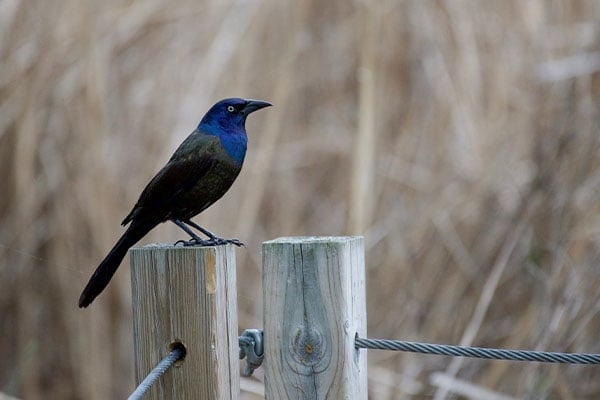
Common grackle facts
- Common Name: Common Grackle
- Scientific Name: Quiscalus quiscula
- Scientific Family: Icteridae
- Life Span: 22 years
- Size: 11.0 to 13.4 inches
- Wingspan: 14.2 to 18.1 inches
- Weight: 2.6 to 5.0 oz
- Conservation status: Near Threatened (NT)
Common grackle: how-to identify
Common Grackles are large blackbirds with strong legs and a long tail. What’s interesting here is that their tail makes up nearly half of their entire length. You’ll also notice that they have a flat head and a long, downward curved bill.
These birds appear black from afar, but it’s glossy. Their plumage is a combination of purple, blue, or green (on their heads) and bronze (on their bodies). Their eyes are pale yellow that contrasts nicely with their dark colors.
Differences Between Male & Female
An adult male and female Common Grackle looks the same – long tail, long bill, and large bodies. Color patterns are also very similar, but females are less glossy than males.
Differences In Summer Plumage vs Winter Plumage
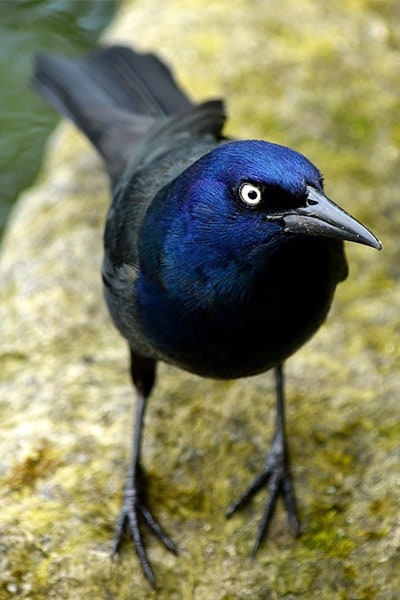
Common Grackles retain their glossy black plumage throughout the year. However, it has been noted that Common Grackles’ plumages in different parts of North America differ – bronze iridescence, purplish iridescence, and green iridescence. So, depending on where you are, you might see a different color pattern for these birds.
Common grackle bird vocalization
Where You’ll See A Common Grackle
Common Grackles are found throughout eastern North America, east of the Rockies. Three subspecies are noted in three different areas – the bronzed from the northwest of the Appalachians, the purple from southeast of the Appalachians, and the greenish from Florida to southern Louisiana and South Carolina.
These birds live in various environments, may it be human landscapes or natural habitats. Typical habitats where you’ll find the birds are in open woodlands, forest edges, swamps, marshes, meadows, and grasslands. They can also be found in agricultural fields, public parks, suburbs, pine plantations, and many more.
As long as there are scattered trees for nesting and open ground where they can search for food, you’ll find these birds.
Common grackle bird migration
Common Grackles are said to be resident or short-distance migrants. Those in the southern part of North America mainly stay there throughout the year while northern populations migrate.
These birds migrate in flocks, and it usually starts late in August, but the majority of the birds leave around October or early November. Then around mid-February to March or early April, the birds start arriving in the breeding areas.
Common grackle diet
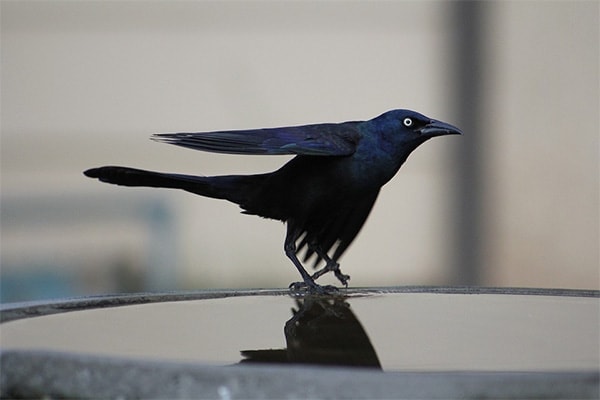
Common Grackles are referred to as opportunistic feeders because their diet depends on what food they’ll find. So, most of the time depends on what is most abundant in a certain season.
If it’s the breeding season, the birds will eat insects and other invertebrates most of the time. This includes small fishes like goldfish and crayfish, small frogs, salamanders, rodents, and sometimes small bats. They also eat beetles, grasshoppers, spiders, worms, and caterpillars.
During winter, the birds would mostly eat seeds. Most of the time, it’s agricultural grains like corn and rice. They also eat sunflower seeds, acorns, sweetgum, and a lot more. They also eat fruits.
So, since these birds eat whatever they could find, they would also sometimes eat garbage. They search for food mostly on the ground and sometimes in shallow waters (where they get fish) and trees.
There are also instances when they steal food and various items from other birds or nests.
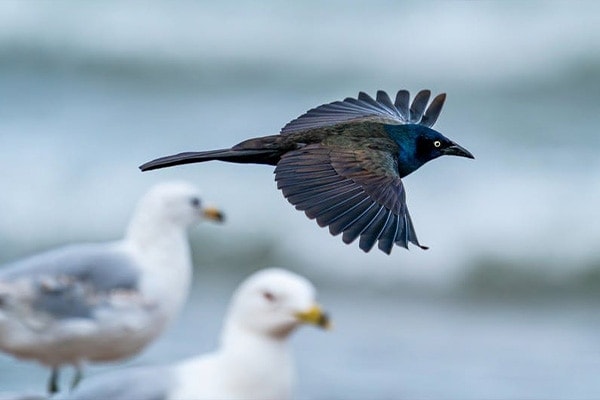
Common grackle nesting
- Clutch Size: 1-7 eggs
- # of Broods: 1-2 broods
- Incubation Period: 11-15 days
- Nestling Period: 10-17 days
- Egg Description: Light blue, pearl gray, white, or dark brown
Common Grackles usually nest by forming small colonies of up to 30 birds, and pairs are usually monogamous. Once a pair forms, the female chooses the nesting site and sometimes ends up choosing more than just one site to build a nest.
It seems that these birds don’t have a particular area they love. Some birds opt to build nests on high coniferous trees, others in low vegetation, and some even build their nests in water. On rare occasions, there are nests in birdhouses, woodpecker holes, barns, and even nests that are still occupied.
Once the nest site is decided, the female Common Grackle usually takes up to six weeks to finish, especially if they keep changing sites. Males also help sometimes and do the repairs.
Nests built by females are usually large and bulky. The foundation is mainly made of weeds, grasses, twigs, and feathers and then lined with mud and fine grasses or horsehair.
Common grackle behavior
Common Grackles are known to be very sociable birds. Whether it’s winter or summer, the birds gather together, and their numbers sometimes reach up to a thousand. Sometimes, they even gather with other bird species like the red-winged blackbirds and European starlings.
Even those who are breeding often gather in one colony. But, they can be very territorial when they are around their nest sites. There have been times where Common Grackles attack their kind and other bird species and also eat eggs and nestlings of other birds.
These birds are known to be loud and very noisy. They can also be very dominant and push aside other birds to get food at bird feeders.
How-to attract common grackles
Common Grackles are frequent visitors of bird feeders. Not everyone wants to attract them because they tend to dominate over other birds. However, if you’re going to attract these species, all you need is to set-up your backyard with all their needs.
So, set up some bird feeders around your backyard. You can use mainly grains and seeds. It will also help if you scatter some grains and seeds on the ground as well. This way, the birds would forage on the ground and not touch the bird feeders, leaving some space for other birds.
If you want them to nest, you can also plant trees or low shrubs where they can start breeding. And don’t forget to have some water ready that they can drink or bathe into. This can be done by installing a bath for birds in your yard.
Common grackle threats
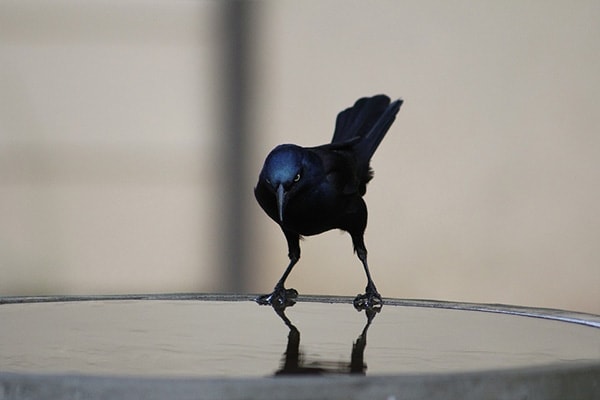
Common Grackles are very widespread across North America. One biggest threat to their population is humans, who kill them as they are considered agricultural pests. On top of that, they also have many predators like squirrels, chipmunks, snakes, hawks, owls, and domestic cats.
Common grackle fun & interesting facts
- Common Grackles have magnetite in their heads, beaks, and necks that help them in navigation.
- These birds practice “anting,” which helps get rid of parasites from the bird’s feathers.
- They have declined by more than 50 percent from their original numbers.
- The oldest Common Grackle lived for 23 years.
- They are considered agricultural pests as part of their diet is corn.
- The birds have a hard keel inside their upper mandible, which is used to open corn.
- Yellow-headed Blackbird
- Bobolink
- Western Meadowlark
- Eastern Meadowlark
- Orchard Oriole
- Hooded Oriole
- Bullock’s Oriole
- Spot-breasted Oriole
- Altamira Oriole
- Baltimore Oriole
- Audubon’s Oriole
- Scott’s Oriole
- Red-winged Blackbird
- Tricolored Blackbird
- Shiny Cowbird
- Bronzed Cowbird
- Brown-headed Cowbird
- Rusty Blackbird
- Brewer’s Blackbird
- Boat-tailed Grackle
- Great-tailed Grackle

